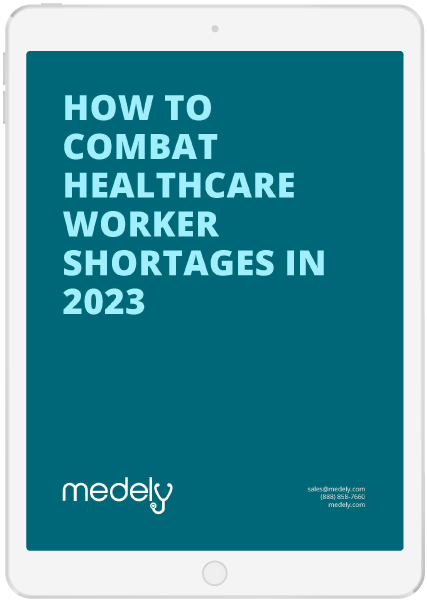Takeaways
- Nurses are leaving the healthcare industry or taking long leaves of absence because of low pay, little opportunity, and lack of respect for their work.
- Turnover and vacancies affect facility profits from canceled appointments and procedures, poorer patient care, and the cost of healthcare professional recruitment.
- Planning and implementing an extended workforce program that’s right for your facility can help you effectively combat healthcare labor shortages and meet the changing landscape of the healthcare labor market.
Why nurses and allied professionals are leaving facilities and hospitals
Much has been written about the effect the COVID-19 pandemic had on the American workforce. The one constant theme is that workers’ attitudes about work and how to make a living have changed. In a survey conducted by Pew Research, they found that people leaving their full-time positions were leaving because of low pay, little to no opportunities for advancement, and the lack of respect for what they do.1
Nursing and healthcare staffing has not been immune to these greater market trends. Added to these reasons nurses cite burnout, oversized workloads, and unsafe working conditions as top reasons why they’re leaving their facilities or the profession altogether.2 Facilities are trying their best to effectively combat healthcare labor shortages and manage their workforce while balancing patient care and operating within or below budget. But, labor shortages are making it increasingly difficult for facilities and their existing staff.
How turnover and vacancies are affecting facility profits
Lowered levels of patient care
With fewer trained professionals and higher levels of incidents, levels of patient satisfaction can be affected because of diminished quality of care, patients losing confidence in the facility’s ability to take care of their needs, and physicians struggling to implement treatment plans.3 This leads to dissatisfaction among nurses, allied pros, and physicians. And, patients will no longer utilize or refer to these facilities as reliable and look for care elsewhere.

How to effectively combat healthcare labor shortages in 2024
Learn how to effectively combat healthcare labor shortages with an extended workforce to maintain continuity of care and gain access to tools you can use to manage your extended workforce more effectively and efficiently. In this eBook, you’ll learn:
- ■ Why nurses are leaving full-time jobs behind.
- ■ The factors impacting healthcare professional employment.
- ■ How you can use an extended workforce to meet demand.
- ■ How you can use data-led staffing planning to manage costs.
Missed Care
The cost of recruitment and training
The cost of healthcare professional turnover is also tied to the recruitment and training of new staff. The cost to replace a single registered nurse is up to 1.3 times their salary.3 According to the NSI National Health Care Retention Report, a percent change, positive or negative, in nurse turnover can cost or save a hospital an average of $380,600 a year.3 And, without the appropriate amount of staffing, facilities can lose revenue due to the temporary shutdown of services.
An extended workforce can fill the gaps and help facilities reach their goals
Over the last decade, more Americans have turned to the gig economy to provide for themselves and their families. Since 2013, workers engaged in the gig economy have grown by 15%, and within the past year, wages and participation rates have grown by 33%.4 Like other occupations, advances in technology and access to new opportunities have changed nurses’ and allied professionals’ attitudes towards work and the gig economy. Now, more nurses and allied pros are entering talent marketplaces looking for opportunities and flexibility.
Medely helps facilities meet patient demand without adding more stress to their existing staff. Facilities use Medely’s online talent marketplace to connect with credentialed, vetted registered nurses and allied health professionals looking for per diem shifts and assignment requests. Quick access to top-quality pros without the hassle of going through a traditional staffing agency can help your facility address staffing concerns in the event of a healthcare professional departing, a leave of absence, or increased demand.
Also, facilities can leverage extended workforces to manage their overhead costs more easily. A facility staffed completely by full-time employees can incur overhead costs during slower seasons that lower profit margins. With seasonality and growth projections in mind, using an extended workforce to meet demand rather than anticipating it can save facilities on overhead costs.
Here’s how easy it is to post a per diem shift request on Medely.
Introducing an extended workforce program to effectively combat healthcare labor shortages.
Mix and match ratios between per diem and full-time employees
Testing different ratios between your flexible, extended workforce and full-time employees can help you find the right mix for your facility.
Implement a per diem training process
When a healthcare professional is fulfilling a shift, make the first shift goes as smoothly as possible by providing simple, quick training on the software systems you use, supervisory roles across the organization, and best practices for your facility.
Encourage open communication
Make sure that your full-time employees and extended workforce have open lines of communication and a clear understanding of what duties are required of each group. The worst thing for your facility is for the quality of care to suffer because of miscommunication. Putting together a plan and expectations goes a long way toward avoiding poor performance from your workforce.
Why extended workforces will become a necessity
The healthcare industry is struggling to hold onto the employees they have invested resources into training and developing them into contributing members of their workforce. And, this is spreading facilities and their full-time employees thin. Healthcare staffing is trending toward a labor market in which healthcare pros leverage their expertise to work with facilities that can help them meet their personal and professional goals through flexibility and competitive compensation. Medely can help you meet the changes in the healthcare labor market.
Revolutionize your healthcare facility with Medely!
At Medely, we understand the critical role healthcare professionals play in patient care. Our platform can help you address staffing shortages and improve patient outcomes.
Join thousands of healthcare facilities already benefiting from Medely’s:
- Rapid Staffing Solutions
- Qualified and Verified Healthcare Professionals
- Easy Scheduling and Communication
- 24/7 Support and Flexibility
Don’t let staffing shortages affect your patient care.
Citations
1. Parker K, Horowitz JM. Majority of workers who quit a job in 2021 cite low pay, no opportunities for advancement, feeling disrespected. Pew Research Center. April 25, 2023. Accessed May 18, 2023. https://www.pewresearch.org/short-reads/2022/03/09/majority-of-workers-who-quit-a-job-in-2021-cite-low-pay-no-opportunities-for-advancement-feeling-disrespected/.
2. Report: 90% of nurses considering leaving the profession in the next year. Healthcare IT News. March 25, 2022. Accessed May 18, 2023. https://www.healthcareitnews.com/news/report-90-nurses-considering-leaving-profession-next-year.
3. 2023 NSI National Health Care Retention & RN Staffing Report. Accessed May 18, 2023. https://www.nsinursingsolutions.com/Documents/Library/NSI_National_Health_Care_Retention_Report.pdf.
4. 23+ essential gig economy statistics [2023]: Definitions, facts, and trends on Gig work. Zippia. May 12, 2023. Accessed May 18, 2023. https://www.zippia.com/advice/gig-economy-statistics/.
